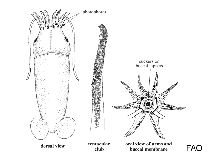Bathyteuthis abyssicola Hoyle, 1885
Deepsea squid| Native range | All suitable habitat | Point map | Year 2050 |

|
| This map was computer-generated and has not yet been reviewed. |
| Bathyteuthis abyssicola AquaMaps Data sources: GBIF OBIS |
Google image | No image available for this species;
drawing shows typical species in Bathyteuthidae.
Classification / Names Common names | Synonyms | CoL | ITIS | WoRMS
Cephalopoda | Bathyteuthida | Bathyteuthidae
Environment: milieu / climate zone / depth range / distribution range Ecology
Pelagic; depth range 100 - 4200 m (Ref. 275), usually 700 - 2000 m (Ref. 275). Polar; 45°N - 70°S, 151°W - 60°W (Ref. 275)
Distribution Countries | FAO areas | Ecosystems | Occurrences | Introductions
Antarctic to Pacific, Atlantic, Indian Ocean and the Mediterranean Sea.
Length at first maturity / Size / Weight / Age
Maturity: Lm ?, range 4 - 5 cm Max length : 7.5 cm ML male/unsexed; (Ref. 104052)
Life cycle and mating behavior Maturity | Reproduction | Spawning | Eggs | Fecundity | Larvae
Main reference
References | Coordinator | Collaborators
Roper, C.F.E., M.J. Sweeney and C.E. Nauen. 1984. (Ref. 275)
IUCN Red List Status
(Ref. 130435: Version 2024-2)
CITES status (Ref. 108899)
CMS (Ref. 116361)
Threat to humans
Human uses
| FishSource |
Tools
More information
Max. ages / sizes
Length-weight rel.
Length-length rel.
Length-frequencies
Mass conversion
Abundance
Internet sources
BHL | BOLD Systems | CISTI | DiscoverLife | FAO(Publication : search) | Fishipedia | GenBank (genome, nucleotide) | GloBI | Gomexsi | Google Books | Google Scholar | Google | PubMed | Tree of Life | Wikipedia (Go, Search) | Zoological Record



